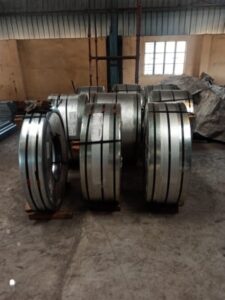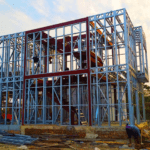How are Light Gauge Steel Frame members manufactured?
Light Gauge Steel Frame Structure members are typically manufactured using a process called cold-forming or cold-rolling. This process involves shaping steel sheets or coils at room temperature without the use of heat. Here is a general overview of the manufacturing process for light gauge steel framing:
Material Selection of Light Gauge Steel Frame Structure
- The primary material used is thin sheets of galvanized steel, usually ranging from 18 to 25 gauge thickness. The galvanized coating helps protect the steel from corrosion.


Coil Processing of Light Gauge Steel frame
- The steel sheets are often delivered in coils. Before forming, these coils may undergo processes such as slitting and leveling to achieve the desired width and flatness.

Cold-Forming or Cold-Rolling
- The cold-forming process involves passing the steel sheets through a series of rollers to shape them into the desired profiles. These rollers gradually bend and form the steel without applying heat.
- Different types of roll-forming machines are used to create specific profiles such as studs, tracks, joists, and other framing components. These machines are often customized for specific profiles and sizes.
Punching and Cutting
- As the steel passes through the roll-forming machine, various punches and cutting tools are used to create holes, slots, and other features required for fastening and assembly. This step is crucial for accommodating electrical wiring, plumbing, and other utilities in construction.
Notching and Embossing
- Some framing members may undergo additional processes like notching and embossing to enhance structural strength, accommodate connectors, or provide a surface for attaching other building components.
Quality Control
- Throughout the manufacturing process, quality control measures are implemented to ensure that the steel framing members meet industry standards and specifications.
Coating
- After forming, the steel framing members may undergo additional processes such as applying coatings or treatments for additional protection against corrosion or to meet specific fire resistance requirements.
Packaging and Shipping
- Once the steel framing members are formed, cut, and inspected, they are typically bundled and packaged for shipping to construction sites.

Light gauge steel framing has gained popularity in construction due to its durability, precision, and ease of assembly. It is commonly used in residential and commercial buildings for framing walls, floors, and roofs.







































